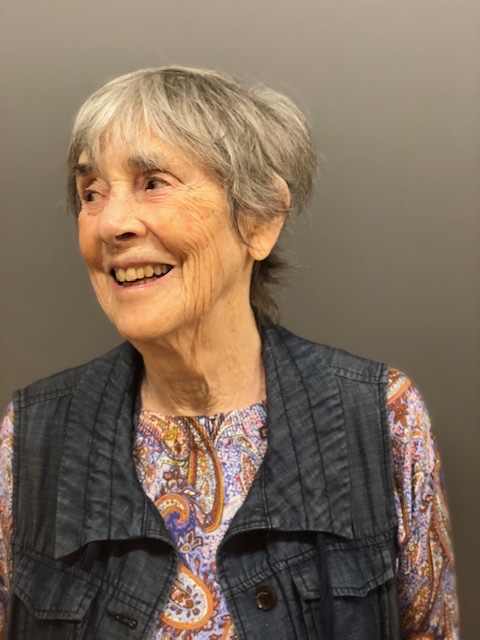
By Anya Schiffrin
Sheila Greenwald, an award-winning children’s book writer and illustrator, has lived on the Upper West Side since 1936. She’s written more than 20 books, most famously the humorous Rosy Cole series about a bright and feisty girl with a passion for social justice and the environment. Greenwald’s husband, George E. Green, was a heart surgeon at St. Luke’s Hospital (now Mount Sinai Morningside) for many years.
Greenwald has just written a memoir of her life in the ‘hood. It’s not yet published for public consumption, but Greenwald hopes her family at least will enjoy her many stories — including tales from the UWS, her time at Sarah Lawrence College, and her friendship with the family of the legendary historian Lewis Mumford.
I knew Sheila and George’s son Sam in kindergarten at Calhoun School, the progressive school on West End Avenue that Greenwald herself had attended in the 1940s. When Sam and I were there in the 1960s, it was still housed in contiguous townhouses; later, it was knocked down and rebuilt to look like a television. Like his mother, Sam spent his life on the Upper West Side. He worked for 30 years as an X-ray technician at St. Lukes Hospital on Amsterdam Avenue and died of Covid-19 complications in April 2020. His brother Ben married a woman from West End Avenue and lived at the Master Building on 103rd and Riverside Drive until moving up to Garrison to be closer to Ben’s Hat Factory in Peekskill, a 19th century factory restored for commercial tenants and art exhibitions.
Below is an email interview (lightly edited) with Sheila’s memories and drawings of our neighborhood.
Q: Incredible that you have lived on the Upper West Side since 1936. What brought you here?
GREENWALD: Even though my father had grown up on the Lower East Side, in 1936 when my parents chose to move from Brooklyn to the UWS, it was because my mother, a country girl, preferred “the better air” near parks and the river.
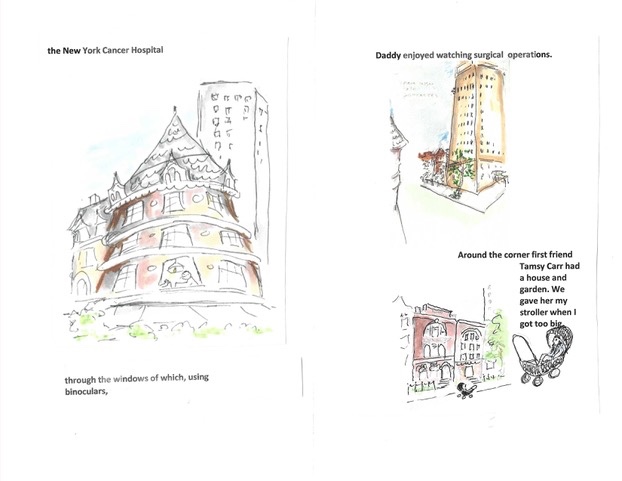
Our first apartment on Manhattan Avenue and West 106th St. was near Central Park and across from a castle called the New York Cancer Hospital, through the windows of which, using binoculars, my father enjoyed watching surgical operations.
In 1938, we relocated three blocks west to a larger five rooms between Broadway and Amsterdam at 211 West 106th St. On moving day, the management gifted us with a dozen roses. Better still, the place was six months’ rent-free. It was the Depression. Birthday parties could be held in empty apartments. As my father would say, it was, “The depths of the Depression.”
For me, 211 West 106th Street was a village where, at an early age, one could experience the thrill of independently visiting friends in their apartments on different floors to discover worlds of taste and habit unlike those at home. During World War Two air raid drills, when [residents of] higher floors were required to descend to lower ones, neighbors who addressed one another as Mr., Mrs., Doctor, etc. became less formal. Children got to know each other.
In good weather, on the sidewalk in front of the building, jump rope, potsy (hopscotch) marbles, trading cards and roller skating were delights. I don’t recall ever seeing a nanny.
Q: Where did you like to go? Any favorite shops?
GREENWALD: In the thirties and forties, the neighborhood was uncrowded. Parking space for cars, never a problem. Shopping with my mother at familiar places like Harold Plofsky’s fish market on Broadway with its tank of listless live carp or Mr. Klein’s butcher shop near Columbus where Sam, the flicker, flicked (plucked) chickens in the doorway, made marketing memorable.
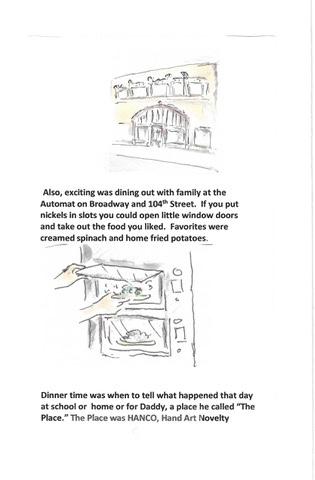 Also memorable and exciting was dining out with the family at the automat on Broadway between 104th St. and 105th St. where, by inserting nickels in slots, like magic, little doors popped open to the food one wanted.
Also memorable and exciting was dining out with the family at the automat on Broadway between 104th St. and 105th St. where, by inserting nickels in slots, like magic, little doors popped open to the food one wanted.
By fourth grade we could, on our own, visit friends after school who lived nearby. On weekends we lined up for double features at one of the three to six (if you included down to 96th St.) neighborhood movie theaters. In winter, there was ice skating at a rink on West End Avenue and 96th.
Travel up and downtown, aside from the subway, was the Broadway trolley, a happy sight to see, waiting for it on the islands in the middle of the avenue. In summer the Riverside Drive bus became double decker with an open top. Our joy ride on a hot day.
Q: How about diversity? Who lived here?
GREENWALD: My classmates at P.S. 54, a pre-Civil War heap on Amsterdam Avenue, were a mix of religions whose families came from Ireland, Italy, Mexico, Eastern Europe, Russia, and Greece. During the Puerto Rican migration to New York [in the 1940s and 1950s], many older, Spanish-speaking classmates appeared in our classroom, challenging a system and teachers who did not speak their language. By war’s end, the Marseilles Hotel on 103rd and Broadway began to fill with those who had fled the war in Europe. Two of them, Peppi and Toby, my father’s young cousins from Hungary, were among them.
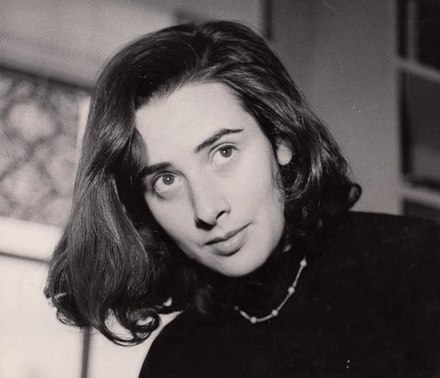
Q: What was the UWS like in the 1960s?
GREENWALD: In the sixties, after my father and a friend were mugged coming home from a restaurant on Amsterdam Avenue, my parents thought of moving to a ‘better neighborhood downtown.’ But we didn’t want to leave the sun-filled, south-facing view in apartment 10B. My mother’s love of uptown air meant the process went nowhere. We joked that the UWS pendulum swings over the years from stable and safe to the opposite. So they told themselves they didn’t have to move, since a better neighborhood would surely be coming back to them.
From the Depression era with its formality, safety, and order, to the sixties and seventies muggings, broken car windows, and families fleeing to the suburbs — only to return to ongoing gentrification — there have been enormous changes. But for those of us who cherish a diverse population, freedom in dress, interaction, and a desire to find out WHAT’S NEXT, I can’t imagine a better place to be.
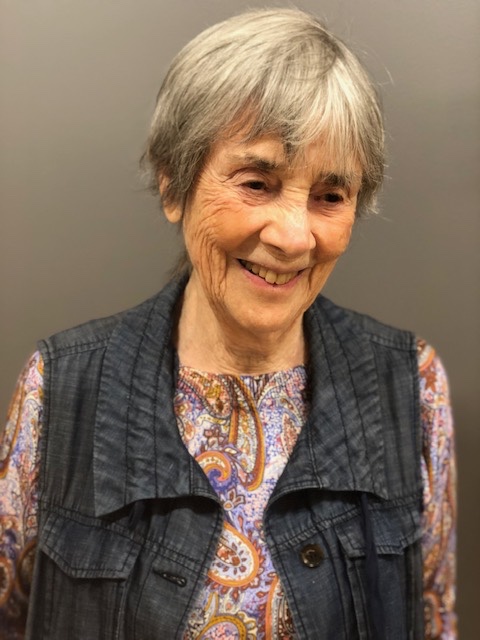
Anya Schiffrin is a Senior Lecturer at Columbia University’s School of International and Public Affairs and a lifelong Upper West Sider.










For those of you who aren’t familiar with the history of the Master, that Wikipedia link is well worth clicking!
How refreshing to see someone who remembers their past fondly but still looks forward to the changes of the future.
Wonderful! Thank you…painting in words (and photos) of blocks I know well. The pendulum does swing.
I still can’t believe there was an ice rink near 96th st. Anyone else remember or gave photos?
I do not recall a ice skating rink but I do remember a roller skating rink. And ping pong! Most important…
Hi Sheila, in 1938 I lived at 207 W 106 th St, the next door building, I remember playing in front of those buildings most days. I was one year ahead of you when I attended PS54. When I was in first grade, we all walked to school together, one parent would see us safely across the intersection. Those are fun times to remember.
Carole Paddi Miller
The ice-skating rink was where Symphony Space & the Thalia are now. I never saw it — just heard about it when we moved to 95th Street.